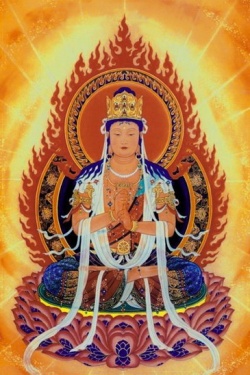Vairochana (Abhisambodhi Tantra)
Vairochana (Abhisambodhi Tantra)
Charya Tantra; One Hundred & Twenty-two Deity Abhisambodhi Vairochana Mandala; (122 One Hundred & Twenty-two Deity Abhisambodhi Vairochana Mandala;
Sanskrit: Maha vairocana abhisambodhi vikurvita adhishtana vaipulya sutrendra raja nama dharma paryaya)
"...Bhagavan Great Vairochana, seated above a white lotus and moon, hair piled on the top of the head, with a crown, upper and lower garments, golden in colour. The two hands perform the gesture of meditation, adorned with all the complete marks on the body." (rgyud sde kun btus, volume 3, page 6).
The Vairochana Abhisambodhi Tantra does not present a Five Buddha system as found in the Yoga and Anuttarayoga classifications of complex mandalas.
Jeff Watt 8-2013
http://www.himalayanart.org/search/set.cfm?setID=896
An inscription on the reverse identifies this painting as the mandala of Abhisambodhi Vairocana ("Mandala of the Awakening of Vairocana"), related to a Sanskrit text entitled, Mahavairocana-bhisambodhi Tantra (rnam-par snang-mdzad mngon-par byang-chub-pa' i rgyud, "Tantra of the Awakening of Great Vairocana").
1 Vairocana appears at the center of the mandala in his two-armed, one-faced form, a rich golden color. His highly complex assembly includes three palace chambers filled with hundreds of attendants.2
The teachings associated with this form of Vairocana were transmitted by a lineage of Buddhist masters represented in the top and bottom registers and enclosed by scrolling vines just outside the mandala proper. Each figure is identified by inscription on the reverse.
The lineage begins with the celestial bodhisattva Vajrapani and includes prominent Indian and Tibetan masters, including Buddhaguhya (sangs-rgyas gsang-ba), who wrote a commentary on the Mahavairocanabhisambodhi Tantra, translated during t he early introduction of Buddhism to Tibet (7th to mid-9th centuries).
Among the last historical figures identified in the lineage is Lama Sangyebum (bla-ma sangs-rgyas-'bum), who, in 1214, became abbot of Tshal Gungthan (mtshal gung-thang) monastery in south-central Tibet.4
1 On this tantra, see Dudjom Rinpoche, The Nyingma School of Tibetan Buddhism, vol. 1, pp. 271-72.
2 A similar, though not identical, Abhisambodhi Vairocana mandala appears in Sonam Gyatso, Tibetan Mandalas, The Ngor Collection, pl. 20.
3 Samten Karmay dates Buddhaguhya to ca. active mid-ninth century. See Samten Karmay, The Great Perfection, p. 240.
For a brief biography of Buddhaguhya, see Dudjom Rinpoche, The Nyingma School of Tibetan Buddhism, vol. 1, pp. 465-66. See also Roerich, The Blue Annals, pp. 351-52.
4 Roerich, The Blue Annals, p. 716.
